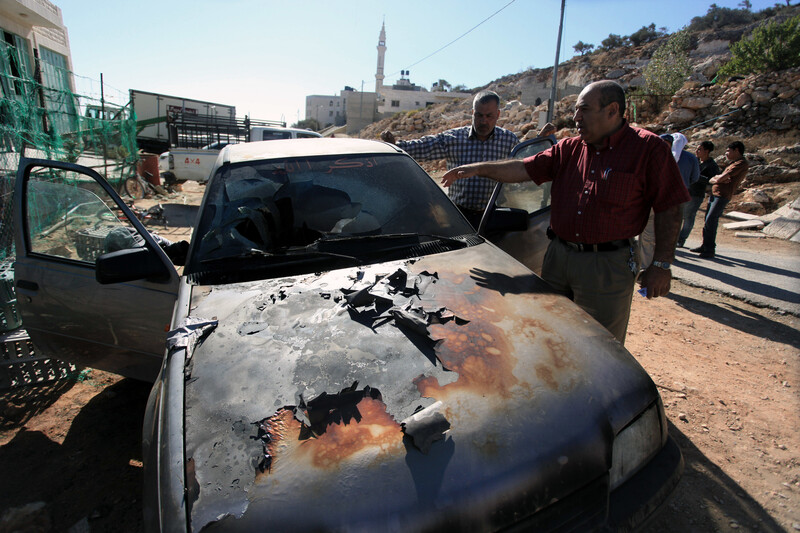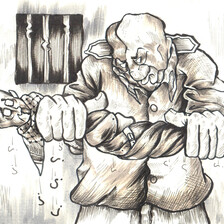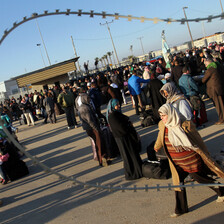The Electronic Intifada Burqa 14 October 2013

Sayel Kanan gestures towards graffiti reading “The redemption of Zion loves Tomer Hazan,” referring to an Israeli soldier recently killed in the West Bank, spray-painted on Burqa village’s mosque.
APA imagesIsraeli settlers raided Burqa, a village near the occupied West Bank city of Ramallah, on 10 October. In addition to vandalizing the village mosque, three cars were also set ablaze in front of their owners’ homes.
This attack and others appear to be in response to the recent killings of Israeli soldiers in the West Bank. A mere fifty meters down the street, the perpetrators spray-painted graffiti on the side of the mosque. “The redemption of Zion loves Tomer Hazan,” it read, referring to an Israeli soldier who was killed in the city of Qalqiliya last month.
The attack followed one in the Jalazone refugee camp, also in the Ramallah area, on 27 September. After setting two cars on fire in the camp, Israeli settlers left graffiti proclaiming that the act was revenge for the killing of an Israeli soldier in Hebron (“Settlers set two cars on fire near Ramallah,” Ma’an News Agency, 27 September 2013).
Despite the illegality of their presence under international law, Israeli settlers face virtually no consequences for their routine violence against Palestinians. Across the West Bank, these settlers have targeted Palestinian holy sites, farmers, buildings and land with increasing frequency.
“They came around 1 o’clock am and wrote on the mosque. Then they set our neighbor’s car on fire before they came to our garage and set my truck and our car on fire,” said Abu Ali Nitham, a farmer who lives at the edge of Burqa.
“They all had weapons”
Although his family woke up from the noise, Nitham was unable to stop the settlers from burning both of his vehicles. “There were six of them and the whole group was armed. I was all by myself — of course, I couldn’t approach them because they all had weapons.”
Nitham said that the attacks came on foot from Givat Asaf, a settlement “outpost” situated on a neighboring hilltop and within plain sight of his home. The outpost has not been given official authorization by Israel.
A mechanic has told Nitham that repair of his truck will cost more than $1,400. Fixing the car, on the other hand, would cost another $850 — more than its total value.
Although the settlers harrass him almost every day while he farms his olive tree orchard, Nitham said that this latest attack was the first time they came this deep into the village.
“We have olive trees and sheep over there,” he said, gesturing to a plot of land connected to his home. “They attack it every day, they burn the trees or tear them out. If you go to the land right now, you’ll find settlers there.”
Desperate as a result of the frequent attacks, Nitham said that he “went to the Israeli police station four or five times. It’s pointless — there are no results.”

Israeli settlers set three vehicles on fire last week in the Palestinian village of Burqa.
APA images“This is neither the first time [the settlers] attacked nor will it be the last,” Nitham added. “Each day they cause more problems.”
In December 2011, a group of settlers, also believed to be from the outpost of Givat Asaf, set fire to the village’s mosque, sprawling racist graffiti across its walls (“Settlers torch Ramallah mosque,” Ma’an News Agency, 15 December 2011).
In early January 2012, a similar group of five or six settlers entered the village in the early hours of one morning and set fire to two cars belonging to Sayel Kanan, acting mayor of the village.
“When they lit the first car on fire, they woke up my 75-year-old mother who lives in the house next to me,” said Kanan. “She started screaming and yelling enough to wake everyone else up.”
Despite his mother’s screaming, the perpetrators remained long enough to set a second car on fire and scrawl “Death to Arabs” on the wall outside the home.
“Thankfully we were able to put out the fire before it spread to the house,” said Kanan. The damage cost him more than $8,500, and he has since spent upwards of $10,000 on security measures to protect his house and family — including reinforcing the fence and installing alarms and security cameras.
Kanan has alleged that these attacks, along with the most recent incident this week, have all been carried about by the same group of young men believed to be from Givat Asaf.
“I’m very sure [the Israeli police] know the perpetrators,” said Kanan.
After the attack on his house, the attack on the village’s mosque, and the most recent incident, Kanan and the other residents of Burqa have attempted to involve Israeli police from the nearby Shaar Benyamin station in the investigation.
“They said they know there are about five to six people from Givat Asaf who are causing problems. They know them very well, but they will never punish them,” said Kanan. In fact, he suspects the same group to be responsible for similar attacks within the surrounding villages.
“Nearly beaten to death”
In August of this year, a 47-year-old Palestinian shepherd, Najeh Thalejeh, was attacked by a group of six settlers in the neighboring village of Mukhmas. The settlers beat him in the head and the chest with knives and rods (“Palestinian shepherd attacked by masked men,” The Times of Israel, 18 August 2013).
“They nearly beat him to death,” said Kanan. It was reported that Thalejeh needed 75 stitches in his head and chest area.
The attack bears resemblance to one which took place on 30 April, when eight settlers attacked Burqa farmer Sayel Muhammad Jaraba and beat him with metal pipes, according to the human rights organization Al-Haq (“In one week: 13 attacks by settlers against Palestinians in West Bank,” 9 May 2013).
“These are not kids. They are a well-organized group with obvious military training. They are armed. They moved like soldiers — they are well-trained,” said Kanan of the attack on his house.
Home to 2,000 Palestinians, the village of Burqa is flanked on three sides by Israeli settlements and outposts, leaving it vulnerable to attacks and military closures. “We are surrounded,” said Kanan.
“On one side we have the settlement of Koukab Yacoub, then there is the outpost Givat Asaf in the north. The area where Migron [another outpost] once was is over there,” Kanan added, pointing towards a military installation, “and Israel’s Highway 60 finished the square.”
“Living in a cage”
“They [the Israeli installations] are all built on a part of Burqa’s land. They have taken about 30 percent of our land, but of course, if you include all the land surrounding them that they prevent us from accessing, then it reaches upwards of 50 percent of our land,” said Kanan.
“We are living in a cage. We can jump and jump, but no matter what, we’ll stay in the cage.”
The Israeli settlement outpost of Migron sat on land belonging to Burqa until Israel’s high court ruled it illegal — it was evacuated in September 2012. Burqa’s villagers say the settlers who lived in Migron have simply moved to Givat Asaf, from where they continue their attacks.
Givat Asaf, built in 2001, was ordered to be evacuated by the Israeli high court in 2011. Its residents vowed to unleash a “tsunami of resistance” and use “violent resistance” to prevent their removal, according to press reports (“Settlers vow to resist future evictions,” Ynet, 7 October 2011).
In May 2013, despite past promises to evacuate all outposts, considered illegal even under Israeli law, the Israeli authorities announced that they were seeking to formally approve Givat Asaf and a few other outposts (“State considering legalizing four West Bank outposts,” The Times of Israel, 16 May 2013).
“The biggest problem we face is from Givat Asaf in the north,” said Kanan. “We face a lot of pressure from them. They’ve taken a lot of land surrounding the settlement. None of the villagers can use their land — if they try, they’ll get seriously hurt. They may even be killed.”
Police “protect settlers”
More than 515,000 Israeli settlers reside in illegal settlements snaking throughout occupied East Jerusalem and the broader West Bank, according to the Israeli human rights group B’Tselem.
Alongside Israeli military installations and industrial zones, these settlements encage Palestinians in small geographical islands with densely concentrated populations, often unable to access their agricultural lands.
Research published by international and Palestinian human rights organizations demonstrate complete legal impunity for Israeli settlers.
“The record clearly indicates that the vast majority of files are closed without even an indictment,” Bill Van Esveld, a researcher with Human Rights Watch told The Electronic Intifada.
“We have seen an increase year after year — a lack of indictments, a lack of prosecutions, and an increase in violence. Those things paint a clear picture.”
Between January and April this year, Al-Haq “documented 58 attacks by settlers against Palestinians and their property,” the organization stated in its aforementioned report. Al-Haq also recorded 13 attacks throughout the course of a single week in April.
Navi Pillay, the United Nation’s high commissioner for human rights, called on Israel to prosecute settler violence in March 2013, stating that “Israel needs to hold perpetrators accountable” (“Israeli settler violence must be prosecuted, says UN chief,” 18 March 2013).
However, there has been little to no effort by Israel’s government to curb or investigate settler violence.
The Israeli human rights group Yesh Din recently published a report that finds that more than 90 percent of the investigations opened into settler violence between 2005 and 2013 “were closed without an indictment being served against suspects” (“Law enforcement on Israeli civilians in the West Bank,” July 2013 [PDF]).
“They make you feel like they’re trying to help you, but in reality, they will never help any Palestinian citizen,” said Kanan. “The Israeli army and police are here to protect the settlers … that’s it.”
Patrick O. Strickland is an independent journalist whose articles have appeared on Al Jazeera English, Truthout and The Electronic Intifada. Follow him on Twitter @P_Strickland_.
Dylan Collins is a freelance photojournalist and writer based in the West Bank. His work has published by Al Jazeera English, Al-Akhbar English, Mondoweiss and elsewhere. Follow him on Twitter @CollinsDyl.





